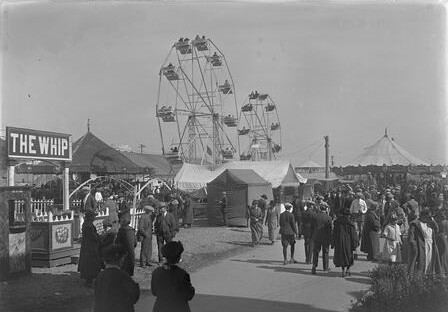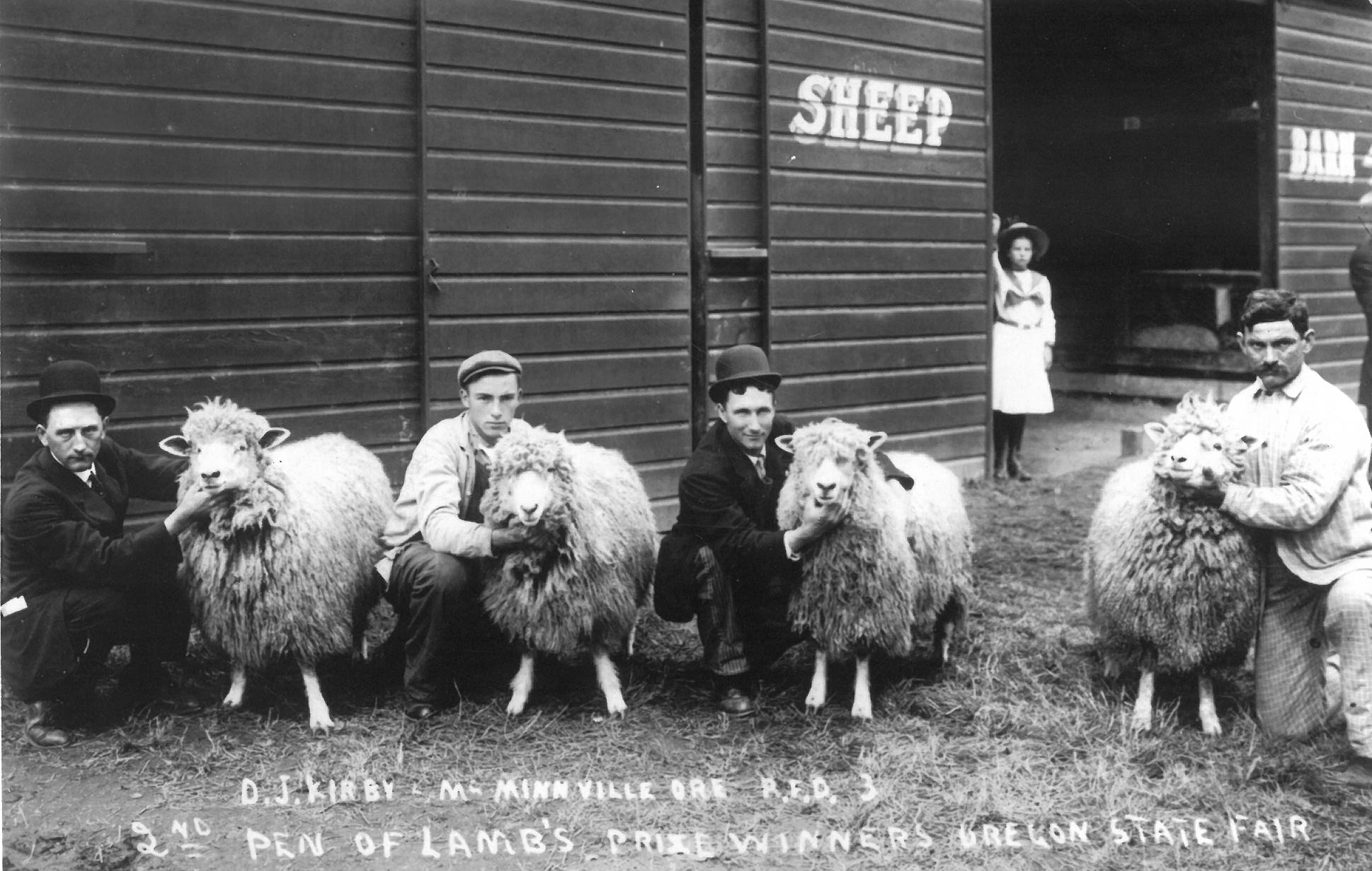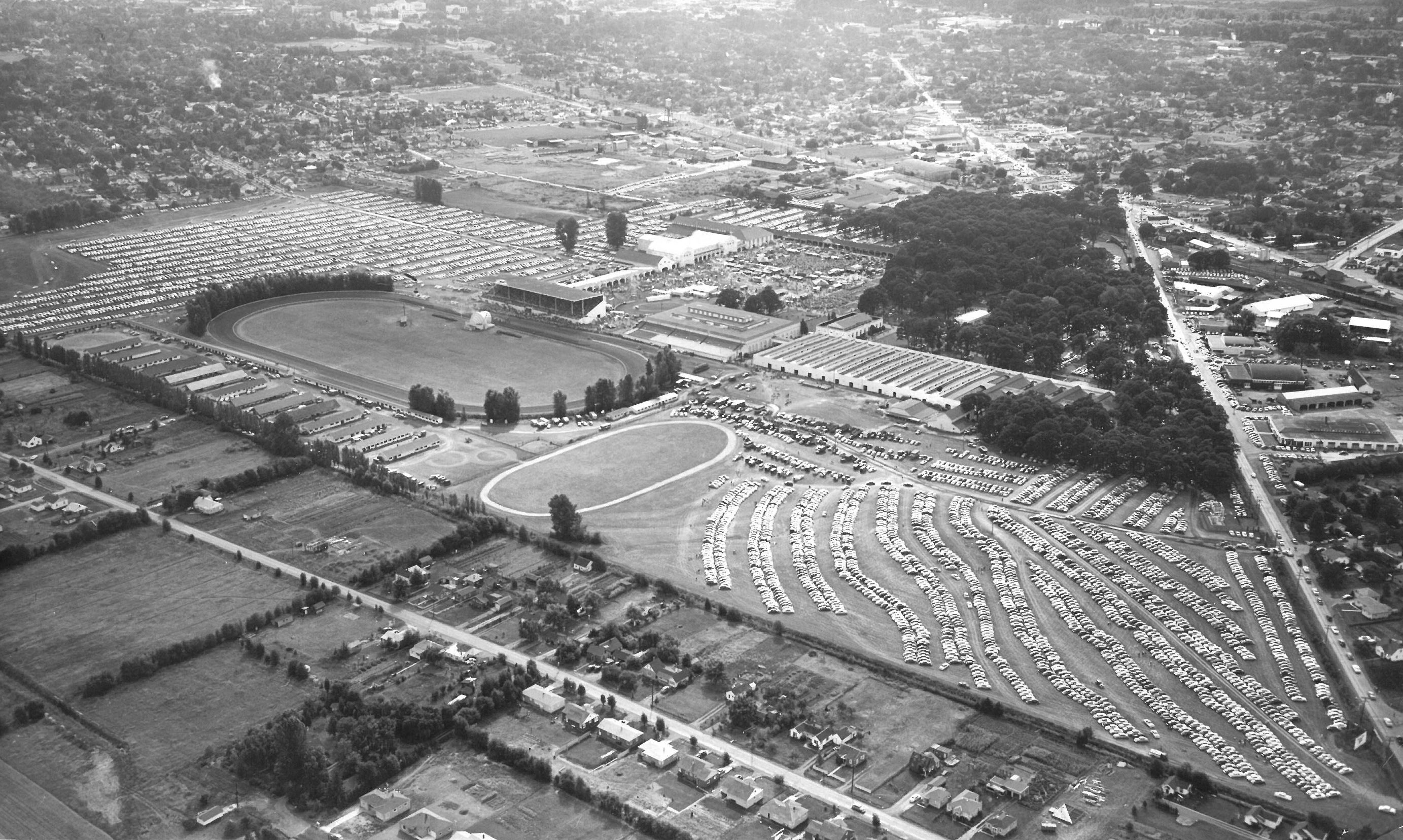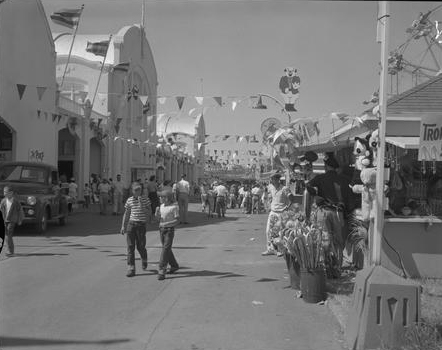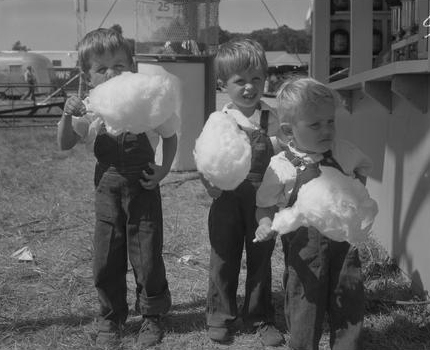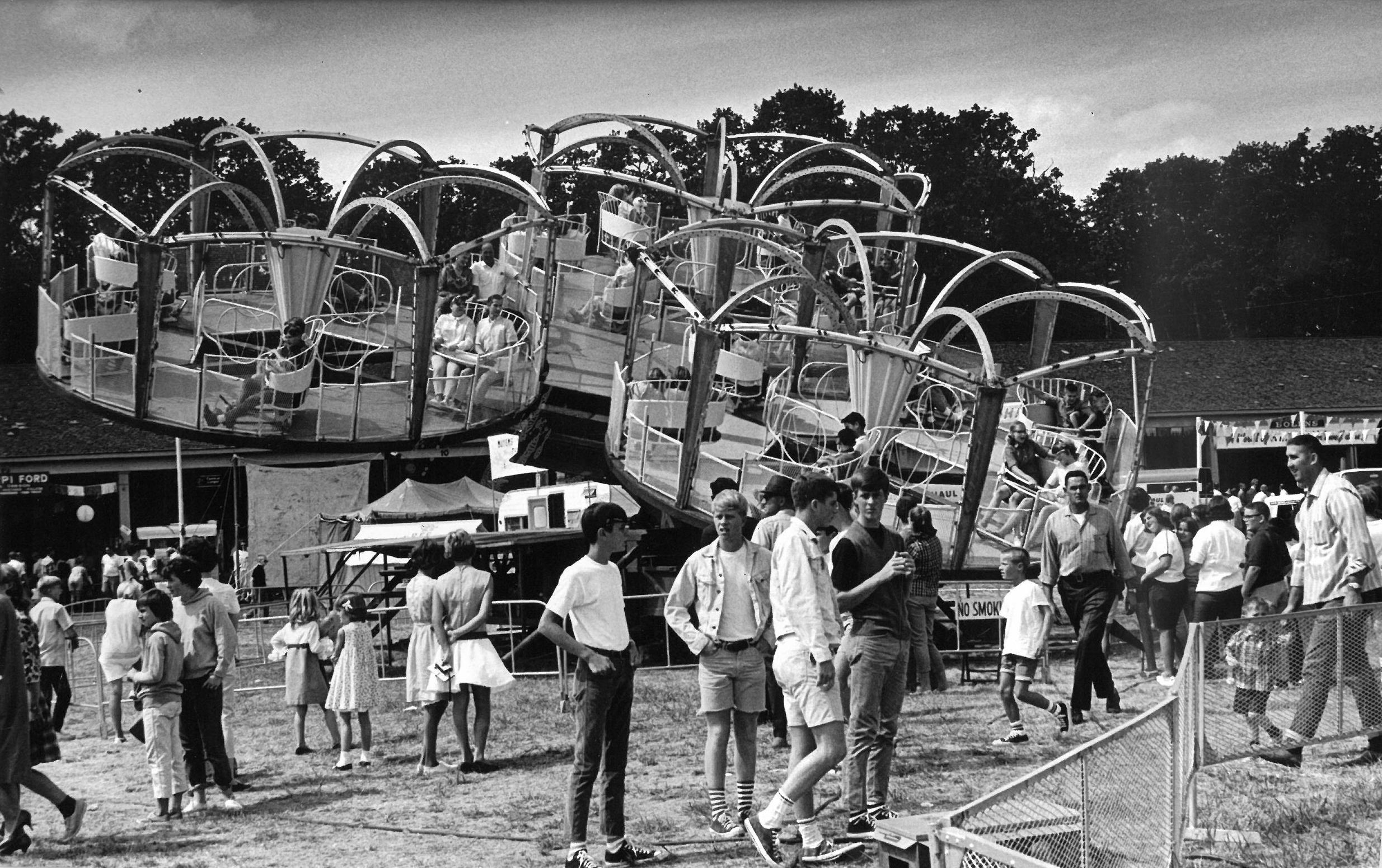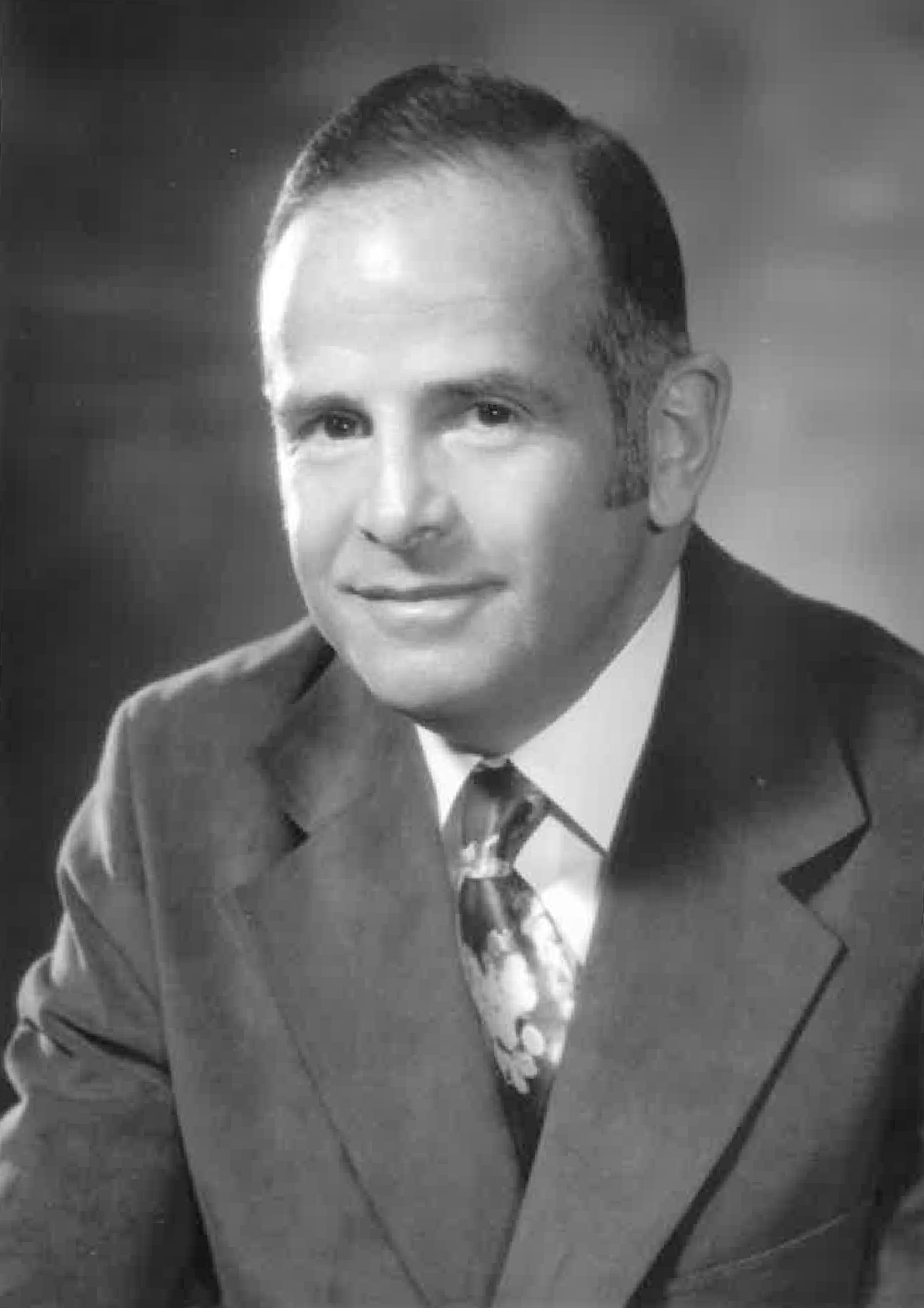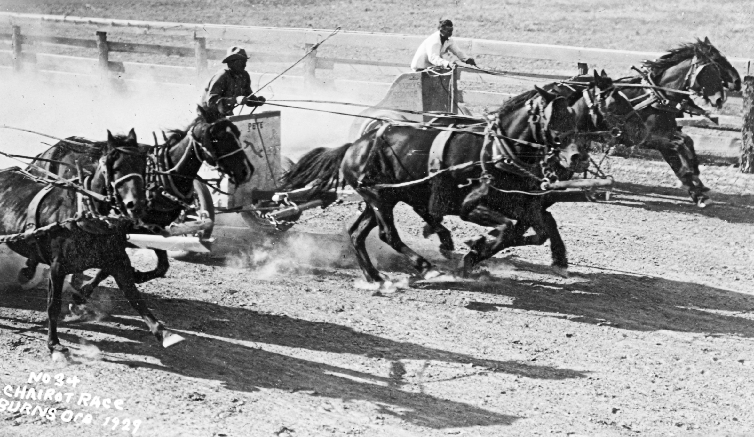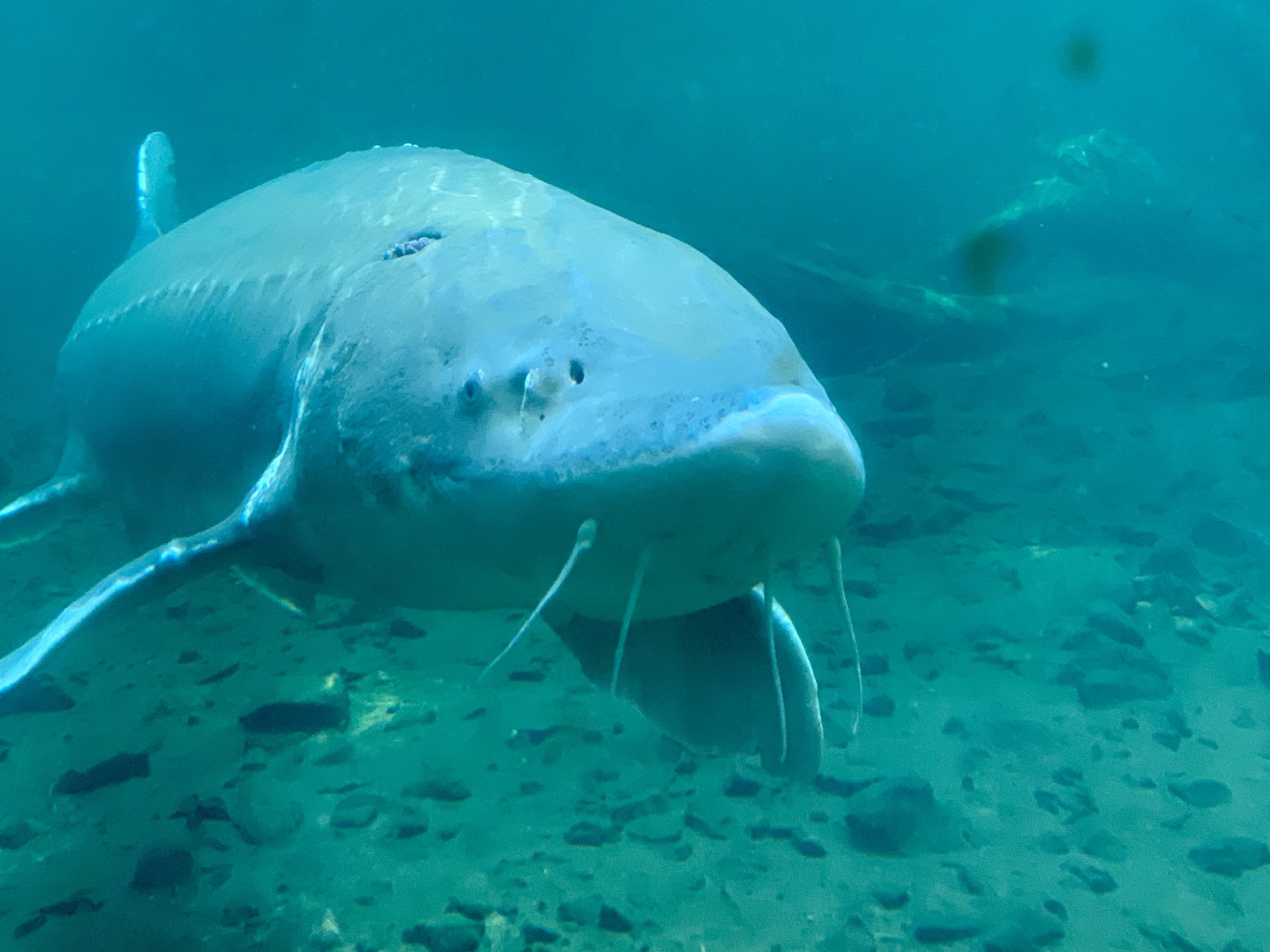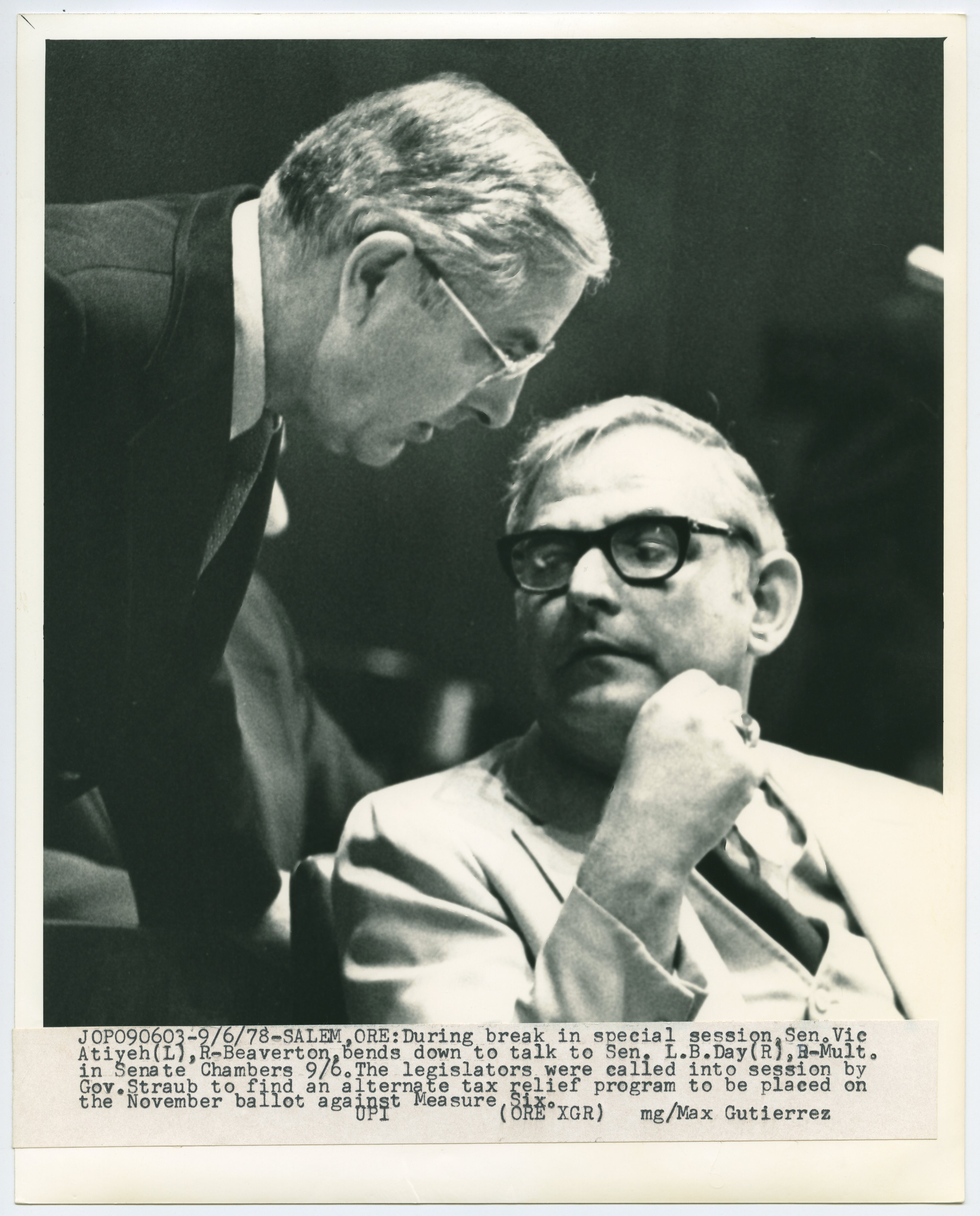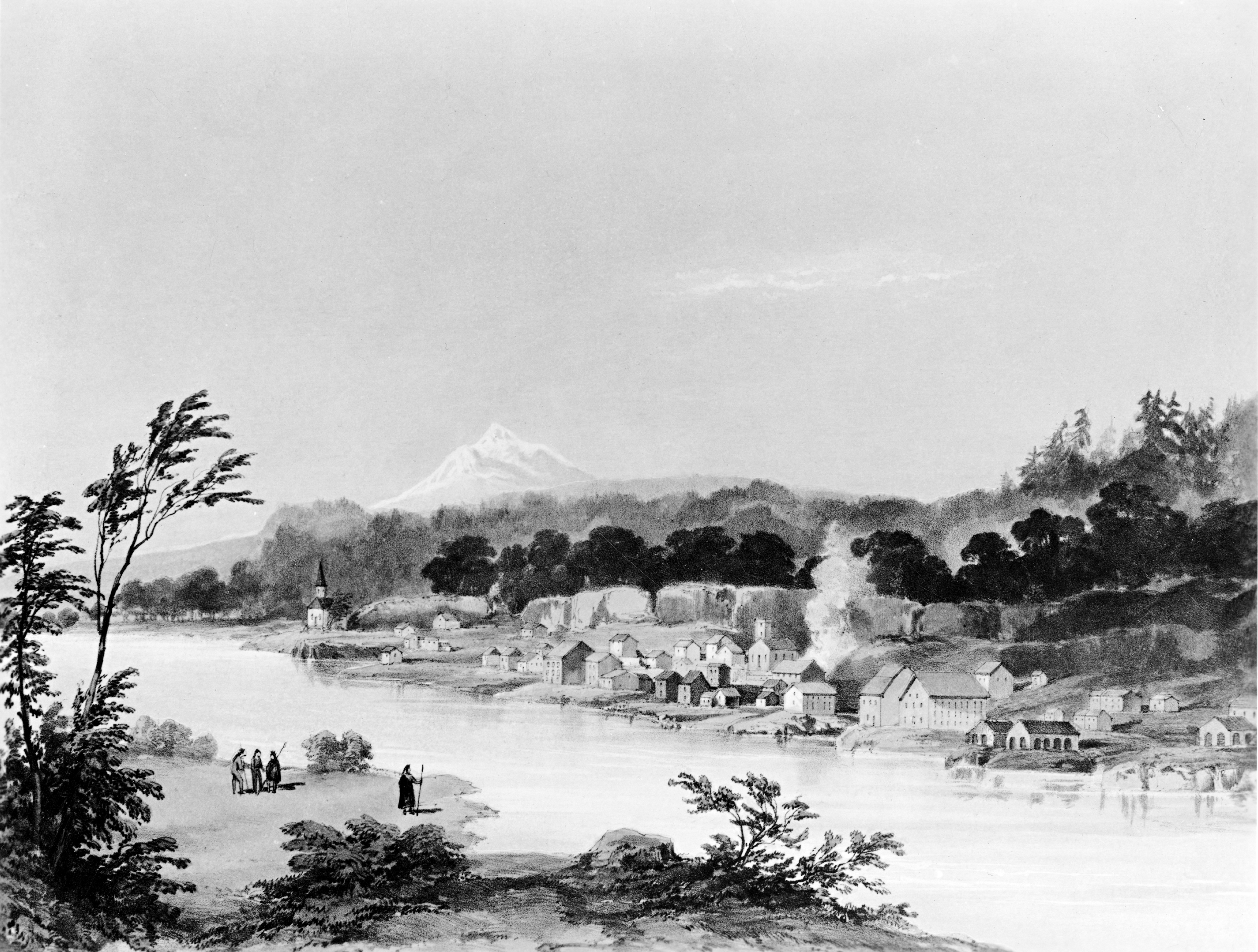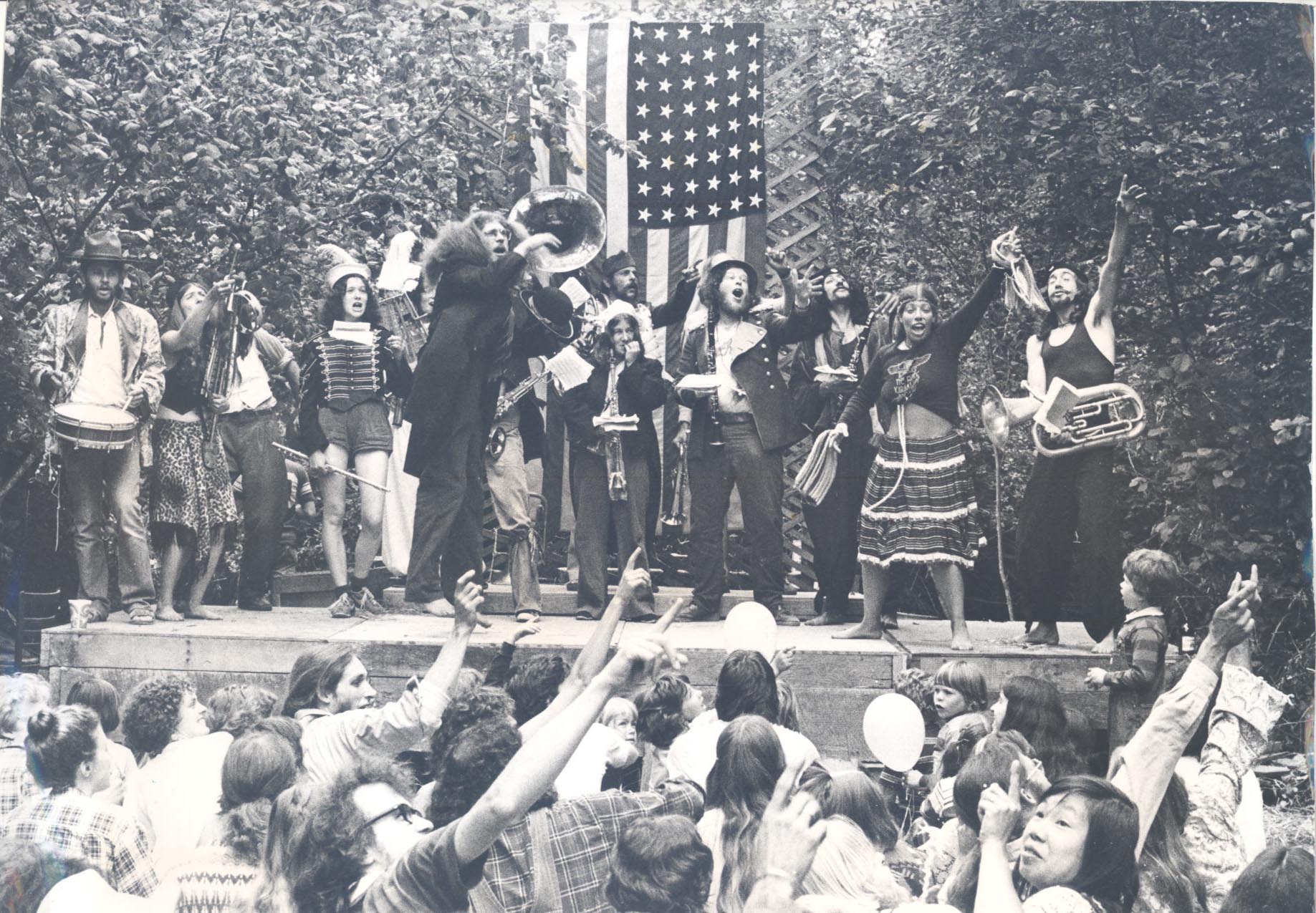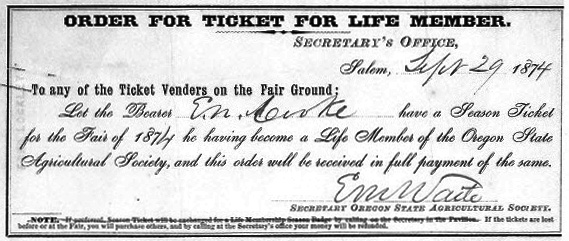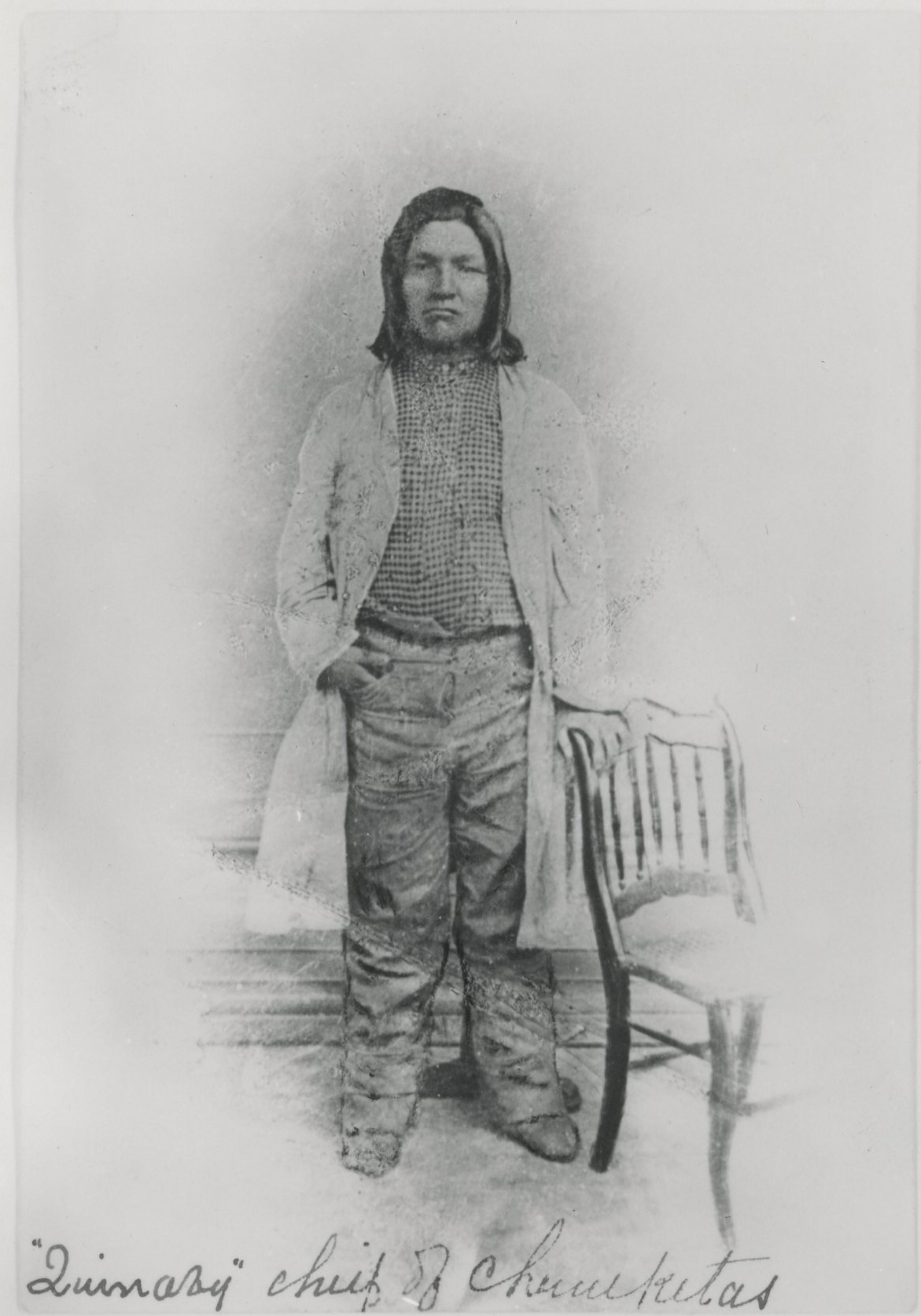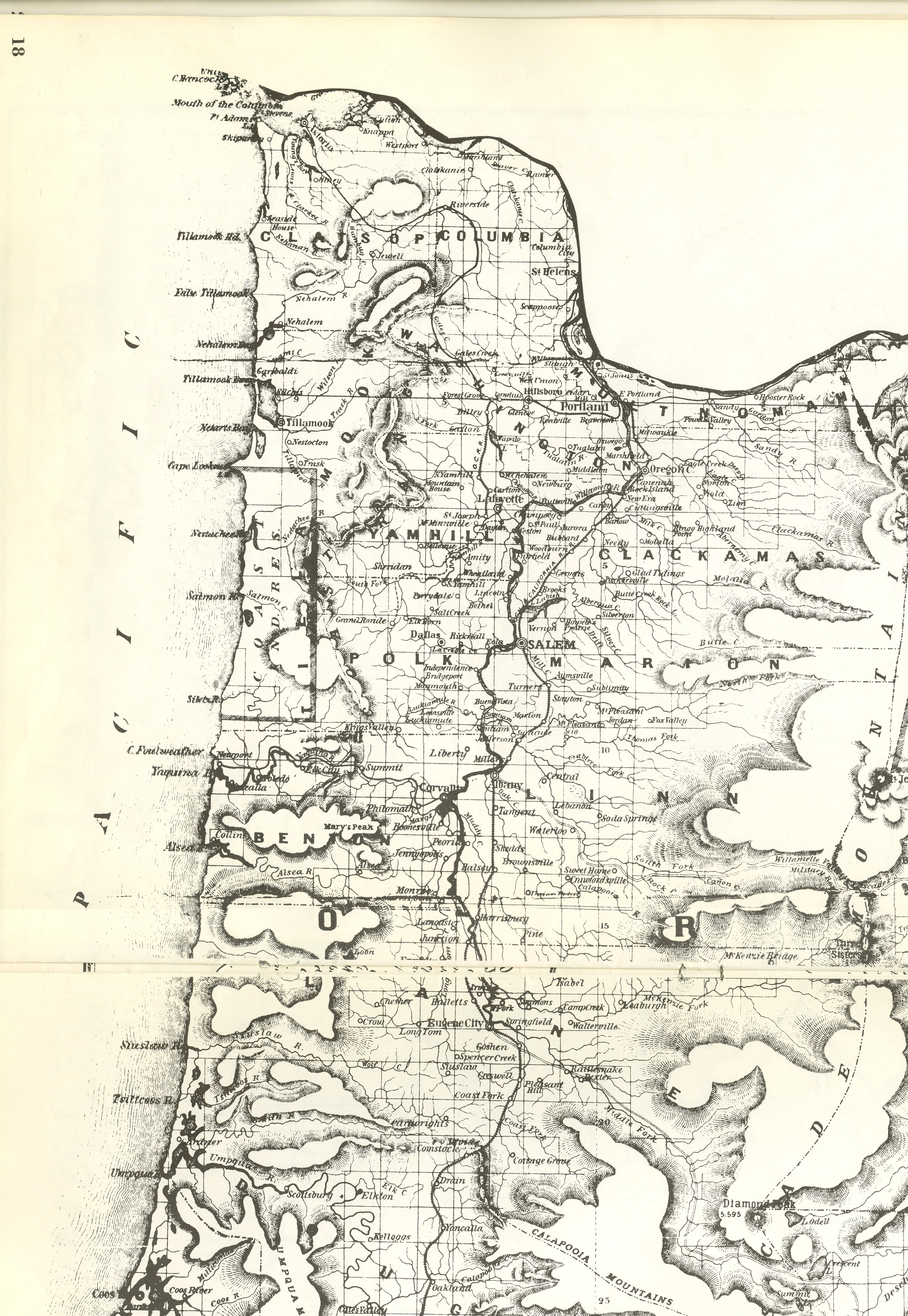The call for an Oregon State Fair intensified in 1859 after California held its first fair, and the Oregon State Agricultural Society (OSAS) was established in February 1860 to make it happen. By then, the Willamette Valley had become a prosperous farming area, and Oregon was establishing itself as an agricultural center. County agricultural associations had formed as early as 1853, and most were already holding their own county fairs. After a year’s delay while OSAS searched for a suitable location, the first Oregon State Fair opened on October 1, 1861, near Oregon City in Clackamas County. The fair, now located permanently in Salem, has been held every year since then except in 1905, during the Lewis & Clark Exposition; in 1943–1944, during World War II; and in 2020, during the Covid-19 pandemic.
In the weeks leading up to the first Oregon State Fair, the Oregon City Argus stressed the importance of preparing for visitors and asked business owners to avoid taking advantage of them on prices for buggy rides and meals. Oregon City women were asked to make “cloths, quilts, socks, needle work, bread, cake, preserves, Jellies, canned fruits, pickles, butter, cheese, &c.” And the paper had this enigmatic but ominous warning: “Don’t forget what the people of the State require of you for the Fair. If you do, you will probably regret it.”
The 1861 fair was not a runaway financial success, but it did break even. Over four days, visitors browsed 142 exhibits of livestock, farming equipment, and fruits and vegetables that were in competition to win 262 premiums (monetary prizes) in categories that ranged from “best Oregon-made plow” and “greatest number of apple varieties grown” to “one full set of artificial teeth, mounted on gold plate.” Joel Palmer, the former Superintendent for Indian Affairs for Oregon Territory, took premiums for “best variety of Irish cup potatoes,” his “seedling peach” and his “sample of butter.” Taking five premiums in bovine categories was OSAS co-founder John Minto, a sheep farmer in the Salem area who helped finance the Willamette Farmer. A prize-winning silk bedspread made by Martha Ann Barlow was sent as a gift to President Abraham Lincoln.
The fair brought farmers together to share new technology and to promote their agricultural successes. Space was set aside for camping, and pavilions and a racetrack were built. During a particularly rainy State Fair in 1877, the YMCA pavilion, which was hosting Christian church meetings, was packed. “Although the entertainment is not so exciting as the races,” the Oregonian observed, “their apartments are dryer, a desideratum this weather.” The YMCA also successfully lobbied to have liquor banned from the fair that year.
The four-acre location of the first fair, along the banks of the Clackamas River, was spacious but muddy, and the river flooded during the event. The OSAS committee reconsidered the location for subsequent fairs, deciding that it made sense to move closer to Oregon’s agricultural center up the Willamette Valley. Salem became the fair’s permanent home in 1862.
The locations of the fairgrounds have been central to Willamette Valley tribes and bands, and the entrance to the first fair was marked by a “powwow tree,” which reportedly had been the location of a tribal council. John Minto’s account in the 1874 Willamette Farmer suggests that Indigenous people came to the area during the week of the fair every year—some traveling from as far as the Klamath area—to camp and participate in traditional ceremonies. Chief Quinaby, a Kalapuya from the Chemeketa area, reportedly visited the fair each year. An “Indian village” was part of the fair beginning in the 1930s; and beginning in 2008, tribal members from Indian reservations in western Oregon had an official presence, educating the public about the region’s Indigenous history and performing traditional songs and dances.
State funds took over the fair’s operations in 1885, but for many years it was up to OSAS to make improvements. Getting out of the mud and onto sidewalks (even wooden ones) increased attendance, and by 1870 a railcar carried visitors to the fairgrounds. “When the State Fair was held...in 1861,” the Oregonian wrote in 1901, “the exhibits barely filled a room the size of one of the new wings of the present pavilion. Now...our state fair is the equal of any held in any state in the Union.” By the 1910s, the date of the State Fair had been moved to late summer, and visitors could arrive in an electric railcar.
To help young people develop practical skills such as animal rearing and home economics, the first 4-H programs were launched in Oregon in 1914. Supported by the Oregon State Agricultural College (now Oregon State University), 4-H Club members began winning prizes and now compete in “contests in communications, expressive arts, family and consumer science, horticulture, natural science, and in science/engineering/technology/industrial arts.”
From the beginning, homemade crafts and domestic products were an important part of the fair. In 1975, the name of the home economics building, Women’s World, was changed to Living Arts, and men were invited to compete in events previously restricted to women. In 1981, Oregon wines were made part of the competitions; six years later, at the urging of homebrew icon Fred Eckhardt, an amateur beer competition was added.
Securing high-quality entertainment became a priority in the twentieth century, and hundreds of musical acts were booked over the decades, including Sammy Davis Jr. in 1946 and the Steve Miller Band in 1998. In 2000, fairgoers were disappointed when Salem’s noise ordinance prevented the British heavy metal band Def Leppard from performing (many guests demanded a refund). At the 1979 fair, Rufus the Bull became a local sensation when he escaped from his handlers who were unloading him from a trailer. After running through downtown Salem, fording the Willamette River, and racing across a golf course, Rufus had all but disappeared until he was found almost two months later in a farmer’s cornfield. Impressed with the steer’s verve, fair officials bought the bull and made him the fair mascot. Rufus served in his post for seven years until he died in 1988.
And then there was the Chocolate Cake Competition. In 1958, gubernatorial hopeful Mark Hatfield promised his administrative assistant, Gerry Frank, that he could the judge the competition if Hatfield won the election. Hatfield won, and Frank’s role as judge was secured. He tasted and judged every chocolate cake entered in the contest for over sixty years, until his death in 2022.
The fairgrounds and buildings have been expanded and reconfigured over the years. A fire in 1967 destroyed over a third of the exhibit space, and by 1974 the loss of infrastructure had taken its toll. The deterioration of the grandstand culminated in the last horse races being held during the 2000 fair, and the grandstand was demolished in 2002. Longtime exhibitor Mary Kay Callaghan teamed up with fair manager Lillie Ward and Oregon State Senator L. B. Day to form Operation Fairsaver. The nonprofit group secured $4.9 million—including $3 million from the legislature—to make upgrades to keep the fair running. In 1987, a year after Day’s death, the L. B. Day Amphitheater was named for him. The main pavilion, first built in the 1870s, has been replaced several times, most recently in 2004.
The State Fair Commission was formed in 1951, with members appointed by the governor. Since 2013, the fair has been governed by the Oregon State Fair Council, a public corporation. In 2023, the fairgrounds stretched over 185 acres, with 115 buildings to accommodate the more than 400,000 people who attend the twelve-day event each summer. On its busiest days, the fair has been the fifth most populated “city” in Oregon, requiring its own police force.
Two historic buildings at the Oregon State Fairgrounds—the Horse Stadium, built in 1919, and the Poultry Building, built in 1921—are scheduled for restoration and preservation by the Oregon State Fair Foundation and the Oregon State Fair & Exposition Center, which now administers the fair. The Horse Stadium is the oldest state building in continuous use, and both buildings were listed on the National Register of Historic Places in 2002.
-
![]()
-
![]()
2nd Pen of Lamb's Prize Winners, Oregon State Fair.
Oregon Historical Society Research Library, Photo file #931-G, Neg #37582
-
![]()
Oregon State Fair midway, August 31, 1952.
Oregon Historical Society Research Library, Photo File 3931-G, OrHi 102230, Oregon Journal Photo
-
![]()
Oregon State Fairgrounds, September 1954.
Oregon Historical Society Research Library, Photo file #831-G, OrHi 105846, Oregon Journal Photo
-
![]()
Cupcake judging contest at the Oregon State Fair, September 1954.
Oregon Historical Society Research Library, Photo File #931-G, OrHi 084476, Oregon Journal photograph
-
![]()
Fairway at the 1955 Oregon State Fair.
Oregon Historical Society Research Library, Digital Collections, Al Monner news negatives; Org. Lot 1284; Box 52; 2523-13 -
![]()
Children with cotton candy at 1955 Oregon State Fair.
Oregon Historical Society Research Library, Digital Collections, Al Monner news negatives; Org. Lot 1284; Box 52; 2523-12 -
![]()
Girl with Horse at the Oregon State Fair, 1957.
Oregon Historical Society Research Library, Digital Collections, Al Monner news negatives; Org. Lot 1284; Box 60; 2941-8 -
![]()
Fair amusement rides, c.1960.
Oregon Historical Society Research Library, Photo file #931-G, OrHi 084479, Oregon Journal Photo
-
![]()
Gerry Frank and Florence Neavoll with her winning chocolate cake at the Oregon State Fair, 1979.
Oregon Historical Society Research Library, Digital Collections, Gerald W. Frank scrapbooks and memorabilia; Coll 855; Vol. 131, P. 30; 001
Related Entries
-
![City of Salem]()
City of Salem
Salem, the capital of Oregon, is located at a crossroads of trade and t…
-
![Gerald Wendel “Gerry” Frank (1923–2022)]()
Gerald Wendel “Gerry” Frank (1923–2022)
In 2000, Governor John Kitzhaber named Gerry W. Frank Oregon’s Premier …
-
Harney County Fair, Rodeo, and Race Meet
The first “fair” in Harney County was a media event. On July 4, 1888, a…
-
![Herman the Sturgeon]()
Herman the Sturgeon
Herman the Sturgeon is a 10-foot-long, 500-pound white sturgeon who has…
-
![L. B. Day (1932-1986)]()
L. B. Day (1932-1986)
L.B. Day was one of a handful of political giants who played leadership…
-
![Oregon City]()
Oregon City
Oregon City was the first incorporated city west of the Rocky Mountains…
-
![Oregon Country Fair]()
Oregon Country Fair
Founded in 1969, the Oregon Country Fair (OCF) is a self-sustaining ann…
-
![Oregon State Agricultural Society]()
Oregon State Agricultural Society
On February 22 and 23, 1860, delegates from nine Oregon county agricult…
-
![Quinaby (1815?-1883)]()
Quinaby (1815?-1883)
Quinaby (Quimby, Quiniby), a Tsimikiti (Chemeketa) Kalapuya Indian, saw…
-
![Willamette Valley]()
Willamette Valley
The Willamette Valley, bounded on the west by the Coast Range and on th…
Map This on the Oregon History WayFinder
The Oregon History Wayfinder is an interactive map that identifies significant places, people, and events in Oregon history.
Further Reading
Heine, Steven Robert. The Oregon State Fair. Chicago, Ill: Arcadia Publishing, 2007.
“State Fair Was Opened.” Portland Oregonian, September 24, 1901, p. 4.
“State Fair Building ‘Liberated’ So Men Can Use it Too.” Oregon Journal, May 5, 1975, p. 23.
“Pacific Northwest breweries garner medals at competition.” Portland Oregon Journal, July 14, 1987, p. 75.
“Oregon Historical Society's celebrity chocolate cake 'smackdown' leftover from sweet 1950s political deal.” OregonLive, August 24, 2015, updated January 9, 2019.

